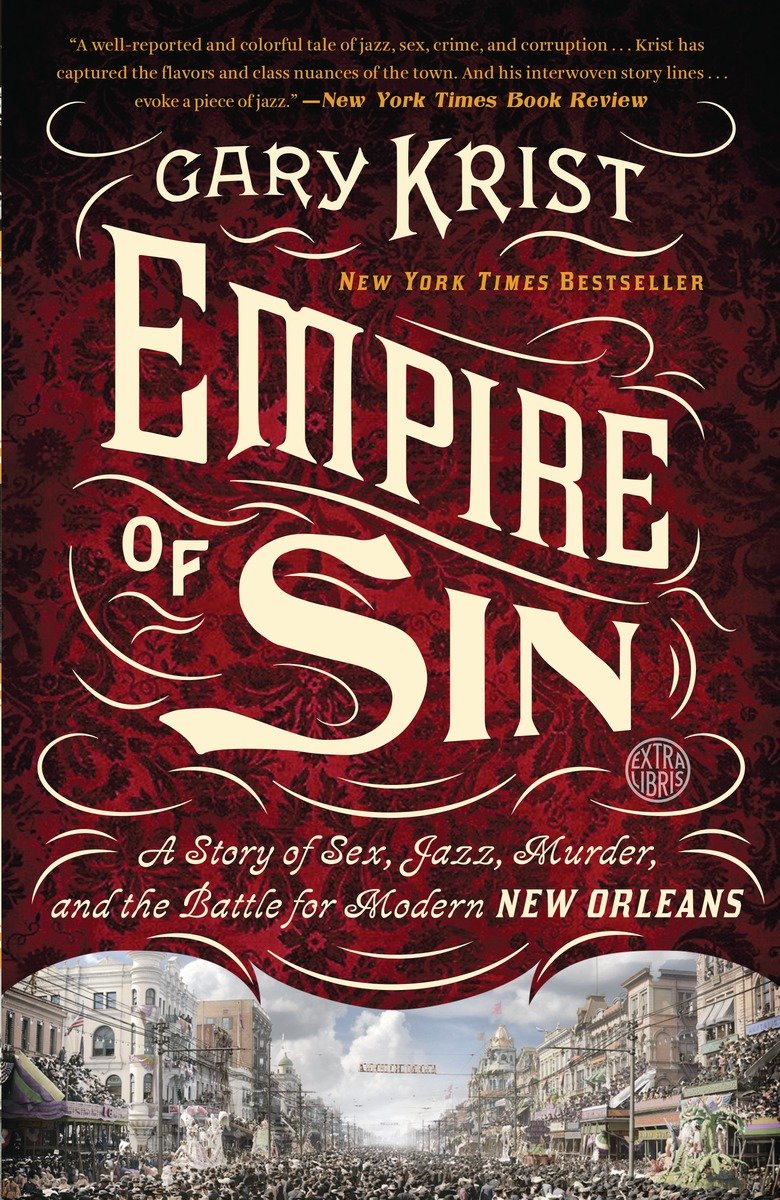Empire of Sin: A Story of Sex, Jazz, Murder, and the Battle for Modern New Orleans
16.00 JOD
Please allow 2 – 5 weeks for delivery of this item
Description
From bestselling author Gary Krist, a vibrant and immersive account of New Orleans’ other civil war, at a time when commercialized vice, jazz culture, and endemic crime defined the battlegrounds of the Crescent City Empire of Sin re-creates the remarkable story of New Orleans’ thirty-years war against itself, pitting the city’s elite “better half” against its powerful and long-entrenched underworld of vice, perversity, and crime. This early-20th-century battle centers on one man: Tom Anderson, the undisputed czar of the city’s Storyville vice district, who fights desperately to keep his empire intact as it faces onslaughts from all sides. Surrounding him are the stories of flamboyant prostitutes, crusading moral reformers, dissolute jazzmen, ruthless Mafiosi, venal politicians, and one extremely violent serial killer, all battling for primacy in a wild and wicked city unlike any other in the world.
Additional information
| Weight | 0.37 kg |
|---|---|
| Dimensions | 2.85 × 12.96 × 20.25 cm |
| PubliCanadation City/Country | USA |
| by | |
| Format | Paperback |
| Language | |
| Pages | 448 |
| Publisher | |
| Year Published | 2015-6-16 |
| Imprint | |
| ISBN 10 | 0770437087 |
| About The Author | GARY KRIST has written for the New York Times, Esquire, Salon, the Washington Post Book World, and elsewhere. He is the author of the bestselling Empire of Sin, City of Scoundrels, and the acclaimed The White Cascade, as well as several works of fiction. He has been the recipient of the Stephen Crane Award, the Sue Kaufman Prize from the American Academy of Arts and Letters, a Lowell Thomas Gold Medal for Travel Journalism, and a fellowship from the National Endowment for the Arts. |
| Review Quote | Praise for Empire of SinWashington Post's Top 10 Best Books of 2014Seattle Times Best Books of 2014Library Journal’s Top 10 Best Books of 2014"[A] well-reported and colorful tale of jazz, sex, crime, and corruption. I can attest, as a native of New Orleans, that in Empire of Sin [Krist] has captured the flavors and class nuances of the town. And his interwoven storylines, intentional or not, evoke a piece of jazz.”—Walter Isaacson, New York Times Book Review“[G]rander in scope and scale…an absorbing history with a body count…Politics, vice and culture are inextricable elements of the whole, and he covers them all with equal skill and devotion… Mr. Krist can turn a phrase with the best. He also allows his characters and sources plenty of opportunity to speak, with the result a delightful conversation. The remainder of Storyville’s tale…provides ample fodder for Mr. Krist’s talent as a storyteller and strength as a researcher. He has written the authoritative account of a raucous American experiment.”—Wall Street Journal"Empire of Sin had me at the subtitle—who could resist a tale that promises sex, jazz and murder in New Orleans?—and the (true) narrative brilliantly delivers. Mr. Krist guides us through a deliciously ribald time in Crescent City history, from the end of the Gilded Age to the dawn of Prohibition, when the city’s elite battled its prodigious and flamboyant underworld." —Karen Abbot, author of Sin in the Second City and Liar, Temptress, Soldier, Spy“Wide-reaching, vividly drawn…Empire of Sin is Krist's meticulously researched, mesmerizing account of New Orleans' outsized vice wars. The book itself is a masterful sleight-of-hand…Moving between parallel narratives, Krist simultaneously — and elegantly — layers more than 30 years of sharply drawn Crescent City social history. It's a backdrop as lush and intricate as a Mardi Gras Ball tableaux vivant — a raucous living portrait…Krist finesses this — lifting data and record to poetry — by procuring specific, redolent details from centuries-old documents…and from them the swirl of frontier New Orleans slides into view. Krist's expansive exploration of the decadeslong battle for New Orleans' soul in the end celebrates New Orleans' character, its essence: the city's long history of defiance and resilience; its ability to pivot in the midst of disaster. Empire of Sin isn't simply the story of how New Orleans came to be, but rather how New Orleans came to learn to fight.”—Chicago Tribune“While there have been many fine books and articles written about New Orleans’ Storyville era… Gary Krist’s “Empire of Sin” is certainly one of the most well-researched and well-written, a true-life tale of a sui generis American city that reads like a historical thriller… The book’s subtitle, A Story of Sex, Jazz, Murder, and the Battle for Modern New Orleans, sums up Krist’s story well — it’s a book both lurid and scholarly, and thoroughly entertaining.”—Washington Post“[I]n Gary Krist’s well-researched account of New Orleans’ turn-of-the-century underworld, there is no mistaking his affection for the ribald and rowdy…Krist is an enthusiastic raconteur of the forgotten. He tears through diaries and old newspapers, bringing fleshy life to what might otherwise dissolve into sepia.”—The Seattle Times"[E]xpertly described…a fascinating and colourful saga that, in the skilful hands of Krist, reads almost like a E L Doctorow novel and invites us all to take a trip 'way down yonder'."—The Independent (UK)“Gary Krist presents a thrilling tableau.”—Minneapolis Star Tribune"Nobody writes about decadence and disaster like Gary Krist…Krist, a superb writer of fiction as well as popular history, has re-created a time and place that we’ll never see again. Empire of Sin is packed with enough color, atmosphere and decadence to fill years of miniseries. You can almost hear Sidney Bechet’s clarinet and Louis Armstrong’s cornet floating through the pages."—Dallas Morning News"New Orleans' venal turn-of-the-century past has gotten a book worthy of the rich material in Gary Krist's Empire of Sin…Krist is masterful at presenting the material, is meticulous about sourcing."—St. Louis Post Dispatch"Unsolved mysteries, murderers on the loose, and the seamy side of the big city: It’s a juicy recipe for a story…a ton of lurid color and character…vivid and thoughtful."—Boston Globe“Gary Krist delves into a dark alley of New Orleans history and drags out a fantastically engaging story that, even though it’s 100 years old, still rings out today…A masterful bit of writing.”—The Baton Rouge Advocate“Krist deftly weaves Anderson's rise and fall into a much broader tale involving race relations, prostitution, jazz, and the underworld of Italian immigrants…What keeps it going are well-crafted vignettes and deftly rendered character profiles, in which reformers aren’t necessarily holy, and their targets are often possessed of considerable charm.”—American Scholar“Empire of Sin: A Story of Sex, Jazz, Murder, and the Battle for Modern New Orleans has something for everyone who has ever staggered down Bourbon Street with a Kindle. Krist spent a lot of time in the city’s great archival collections, wondering why our funky hometown got this way. And, boy did he latch onto a story.”—New Orleans Times Picayune, 50 Fall Events Not to Miss “Focusing on the battle for (and against) morality in 'the Sodom of the South' from the 1890s to the early 20th century, Krist’s hard-to-put-down read recounts a volatile time for vice in a town built on it.”—Where New Orleans"A fabulously rich and colorful chronicle of New Orleans at the turn of the century."—Acadiana Lifestyle“[A] rich, well-structured story more vivid and twist-filled than most crime fiction…Armed with both well-placed primary sources and an addictive, climactic narrative, Krist leads a perfect trip into the short-lived societal experiment aptly named 'Storyville.'”—Publishers Weekly, Starred Review“This engaging work covers the brief and exciting history of Storyville…Krist delivers on his lurid subtitle with stories of the flourishing sex industry, the birth of jazz in New Orleans, and the unsolved case of the "Axman"…Highly recommended for readers interested in New Orleans and also for those looking for a readable collection of true stories from one of America's most fascinating metropolises.”—Library Journal, Starred Review “[An] in-depth, seasoned analysis of the creation, growth, and downfalls of New Orleans, particularly its colorful Storyville area, which was indeed the site of vice and murder of all sorts but also of the birth of entrepreneurships and a music unparalleled in the U.S. of the time…Krist’s well-researched and -told history of New Orleans is an eye-opening tale of a melting pot…. There are characters here, genial, business-savvy, and cruel; concerted efforts to live and let live, along with lawlessness; and righteous reformers, all wrapped into a captivating history of an era and locale that ultimately touched much of America’s arts, attitudes, and outlook. A fascinating, detail-filled tribute to a city and an era.”—Booklist “A colorful account…richly detailed…lively….A wild, well-told tale.”—Kirkus Reviews“In the vein of Erik Larson’s best seller The Devil in the White City, Gary Krist’s exposé of New Orleans at the turn of the century…proves that truth really is stranger than fiction by detailing the prominent figures within Storyville, the Crescent City’s red-light district….Fans of Boardwalk Empire would enjoy this crime thriller as well.”—Library Journal, Top 10 Editors’ Picks BEA 2014"Chronicling New Orleans' history from 1890-1920, Empire of Sin delves into the most shady, sexy, and shameful parts of the Crescent City's past. Even if you are familiar with jazz origins, the Axman murders, or Storyville, Krist introduces a whole slew of personalities that will keep you intrigued from start to finish."—BookPeople |
| Excerpt From Book | It was, in many respects, the most brutal assault so far: a two-year-old child killed instantly by a single blow to the skull; her critically injured parents rendered senseless by multiple head traumas. Clotted gore soaked the bed where they all lay. Across the walls and curtains around them, blood spatters radiated like birdshot. And yet, despite this evidence of what must have been a savage frenzy of violence, no one in the neighborhood had heard a thing. The perpetrator had been able to escape without a single witness to the crime, and with hours to spare before his deed was detected. The axman was apparently becoming even more adept at his trade with time. The crime had been discovered at about seven o’clock on a Sunday morning. Several neighbors had made earlier visits to the grocery, which usually opened at five a.m., and had merely walked away when they found it closed. But one little girl named Hazel Johnson was more persistent. After getting no response at the front door, she decided to try around back. In the alley leading to the rear of the building, she found a chair set up below a side window. She climbed up on the chair and peered inside, but couldn’t see anything in the murky morning light. So she continued down the alley to the backyard. There she found the back door closed, but with one of its lower panels missing. Puzzled, she called a passerby into the yard, and he persuaded her to go inside, perhaps because she was small enough to fit through the missing panel. She crawled in—and moments later burst out the back door, screaming. Aroused by this clamor, a young neighbor named Frank Jordano ran over with his aging father, Iorlando. They found Charles Cortimiglia half-conscious on the floor, and Rose Cortimiglia clutching her lifeless toddler and sobbing inarticulately. Her husband, Charles, roused out of his stupor by the younger Jordano, sat up on the floor. “Frank,” he said. “I’m dying. Go for my brother-in-law.” It was the last thing he would say for several days. Since the town of Gretna was in Lafayette Parish, Peter Leson, chief of the Gretna police, and Lafayette sheriff Louis Marrero would conduct the investigation of the Cortimiglia case, with Superintendent Mooney’s force merely assisting from afar. What Leson and Marrero found at the scene, however, indicated that the crime was clearly related to the previous year’s cases across the river. The axman’s signature modus operandi was obvious—from chiseled door panel to rummaged belongings, with little sign of anything of value actually being taken. This time, a box containing money and jewelry was found undisturbed in the bedroom, along with $129 in cash hidden under the Cortimiglias’ mattress. But two trunks and a dresser had been practically torn apart in some kind of frenzied search; even the face of the mantelpiece clock had been pried open and examined. As in the other axman cases, however, no fingerprints were found anywhere, and any footprints in the yard had unfortunately been trampled by the curious crowd of neighbors that had gathered at the scene after hearing Hazel Johnson’s screams. The discovery of two axes on the premises—one bloody and obviously the murder weapon, another covered with fresh mud—led Leson to believe that two men might have been responsible for this attack. Perhaps one had stood on the chair in the alley to keep an eye on the victims—and simultaneously on the street—while his partner worked on the back-door panel to gain entrance. This two-perpetrator idea could even illuminate one nagging aspect of the earlier attacks. Having an accomplice could explain how the axman was so successful at eluding detection, even while chiseling away at a back door—an activity that must have been noisy enough to be heard by anyone lying awake in bed or passing on the street. In other words, the axman may not have had wings (as the impressionable Bruno girl had speculated), but he could have had a second set of eyes—keeping a lookout while he performed his grim duties inside. But Leson and Marrero were not interested in solving the earlier crimes; they were concerned only with the one in their own jurisdiction, and they pursued their investigation with an aggressive single-mindedness that they would later come to regret. While interviewing the Cortimiglias’ neighbors, they gleaned hints that the Jordanos might not be the Good Samaritans they at first had seemed. According to the neighbors, the two families had been feuding for some time, ever since the Cortimiglias had taken over the languishing Jordano grocery in 1916 and turned it into a success. The Jordanos had taken back the business just a few months ago, forcing the Cortimiglias to find a shop elsewhere in Gretna. But recently the Cortimiglias had come back, setting up a brand-new grocery on the lot adjoining that of the Jordano store. And now, just two weeks later, the Cortimiglias were lying near death after being brutally attacked in the night. When asked about the situation, the Jordanos insisted that they had made peace with the Cortimiglias and were now good friends, but Marrero had his doubts. Back on the other side of the river, Superintendent Mooney continued to insist that all of the ax attacks (except, perhaps, for the Harriet Lowe murder) had been committed by a “degenerate madman,” and that “he ransacked the places he enters to create the impression that robbery is his motive.” The superintendent’s desk was now covered with maps, police reports, and photos of all of the ax cases in the city, and he was reportedly poring over them night and day. According to the Times-Picayune, his collection also included “the opinions of some of the South’s best recognized scientists, placing the axman in the same class as Catherine de’ Medici, the French author Sade, and other historic degenerates.” But the Gretna authorities had a far more mundane perpetrator in mind for the Cortimiglia attack. So sure were they of Frank Jordano’s guilt that they kept asking the Cortimiglias again and again whether he was the man who assaulted them. The victims were still barely coherent and could do little more than nod or whisper in reply. But while Charles Cortimiglia (by some accounts) continued to insist that he did not recognize his assailant, his twenty-one-year-old, highly traumatized wife apparently indicated an affirmative to the question. This was enough for Chief Leson. He promptly had the younger Jordano arrested, despite the fact that the Cortimiglias’ doctor refused to “vouch for the condition of their minds.” “Both Charlie Cortimiglia and his wife, Rosie, told me that Frank Jordano had committed the crime,” Leson told a skeptical press. “We have worked up a strong case against him and I am satisfied that the circumstances surrounding the case justified the arrest.” Frank Mooney ignored these developments in Gretna, preferring to pursue his own theory of the murders. In a high-profile presentation to the press—including, as a visual aid, a large city map marked with no fewer than sixteen alleged axman incidents—the superintendent outlined what he was now calling his “panel theory.” There were common elements, he claimed, not just in the various ax assaults, but also in the numerous attempted ax break-ins that had been reported throughout the city over the past year. And these common elements convinced him that the crimes were all the work of a single man. The Times-Picayune reprinted the commonalities in full: Location— In nearly all of the cases a corner house with a high board fence at the side and rear has been selected, and in most instances it was a grocery or barroom or a combination of both. Time—The hour generally has been about 3 AM. Method—Entrance has been effected by removing a lower panel of a rear door. The plan of work in each instance has been remarkably similar. Weapon—Where the crimes proceeded to the attack, an ax has been used (except in one case where a hatchet was wielded)—sometimes an ax found on the premises, sometimes brought by the murderer, but always an old ax and always left behind. The attack—Always on sleeping victims with no apparent choice between men and women, and use of the blade of the weapon as a rule. Precautions—Complete failure to find fingerprints, together with the fact a pair of rubber gloves was left behind in one case, leads to the belief that the murderer uses rubber gloves to protect himself against identification by the fingerprint method. Robbery as a Camouflage—In practically every ax murder, while bureaus, safes, and cabinets have been ransacked, little was stolen, and money and valuables in plain sight were left behind. And in numerous instances of “panel burglaries,” the work of the intruder has been so incomplete as to leave strong doubt whether robbery was the real motive. Mooney did acknowledge that each assault and break-in could conceivably be a separate, unrelated incident. He also admitted that they all might be part of a systematic campaign of revenge or terrorism by the Mafia or Black Hand. But he remained convinced that the culprit in all or most of the incidents was a “solo maniac”—“a diabolical, bloodthirsty fiend, cunning and shrewd,” as the Times-Picayune described him, “a slinking agent of the devil at 3 AM.” Then, on Sunday, March 16, the city received a kind of confirmation of this macabre description. The Times-Picayune reprinted a remarkable document the paper had received in the mail on Friday. It was an open letter to the public purporting to be from the axman himself. Addressed to the newspaper’s editor, and written in a hand similar to that of the letters received by Superintendent Mooney from the anonymous criminologist, it began with an attention-getting flourish: “Esteemed Mortal: They have never caught me and they never will. They have never seen me, for I am invisible, even as the ether which surrounds your earth. I am not a human being, but a spirit and a fell demon from hottest hell. I am what you Orleanians and your foolish police called the axman.” The letter went on to ridicule the police for their inept investigation of his crimes. The department’s antics had been so “utterly stupid,” in fact, that they had amused not only him, but also “His Satanic Majesty” and the recently deceased emperor of Austria, Franz Joseph, among other denizens of hell. “Undoubtedly you Orleanians think of me as a most horrible murderer, which I am,” he continued, “but I could be much worse if I wanted to. If I wished to, I could pay a visit to your city every night. At will I could slay thousands of your best citizens, for I am in close relationship with the Angel of Death.” The letter writer followed this with a threat, specifying the time of his next appearance: “Now, to be exact, at 12:15 o’clock (earthly time) on next Tuesday night, I am going to pass over New Orleans.” But those in fear of their lives had one way to protect themselves: “I am very fond of jazz,” he wrote, “and I swear by all the devils in the nether regions that every person shall be spared in whose house a jazz band is in full swing at the time I just mentioned. If everyone has a jazz band going, well, then so much the better for the people. One thing is certain, and that is [that] some of those persons who do not jazz it on Tuesday night (if there be any) will get the ax.” The letter was signed, simply: “The Axman.” The sensation created by this letter—particularly in the poorer ethnic neighborhoods that had been hardest hit by the ax crimes—can only be imagined. Certainly many, if not most, people in the city must have doubted the authenticity of the document. There was something too slick—too ironic and knowing—about the entire exercise to be fully convincing as the ramblings of a crazed maniac. But for a populace traumatized by a bizarre and brutal crime wave, the letter was a shock, hoax or no hoax. After all, something was stalking the streets at night with malicious intent. And if the way to appease the demon was to cut loose for a night, then New Orleans, starved of music and conviviality by the forces of reform, would cut loose with abandon. |
Only logged in customers who have purchased this product may leave a review.






Reviews
There are no reviews yet.